I went to write a post about how fabulous Theresa looked in the Little Miss Muffet 1910-11 inspired dress at our photoshoot at Otari Wilton’s Bush, and realised that I’ve never done a post about the dresses construction details.
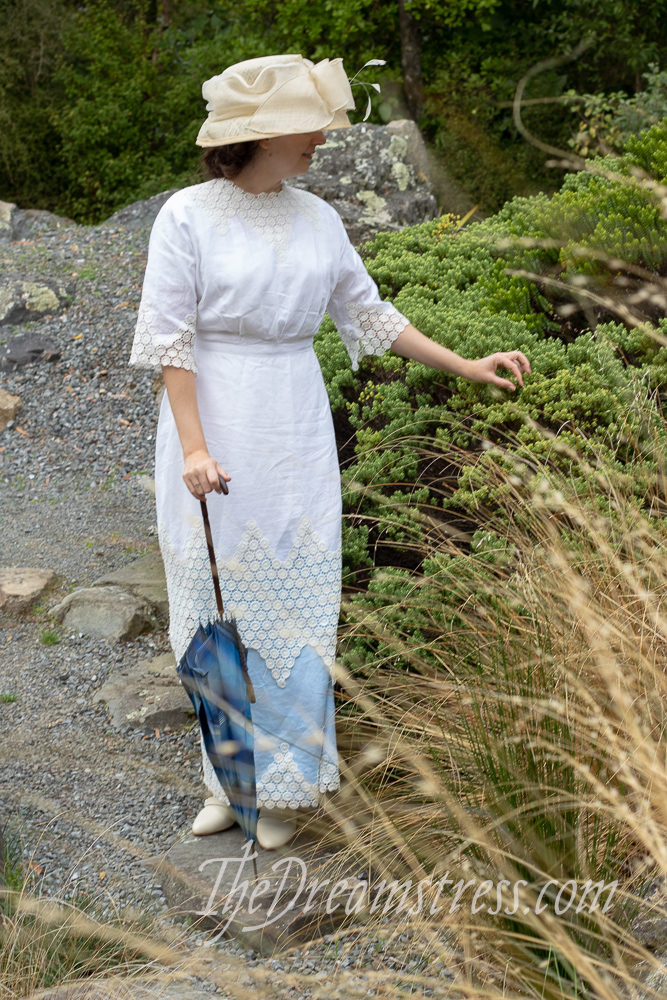
So here is a dual-purpose, word-and-image heavy, post of Miss Muffet dress awesomeness!
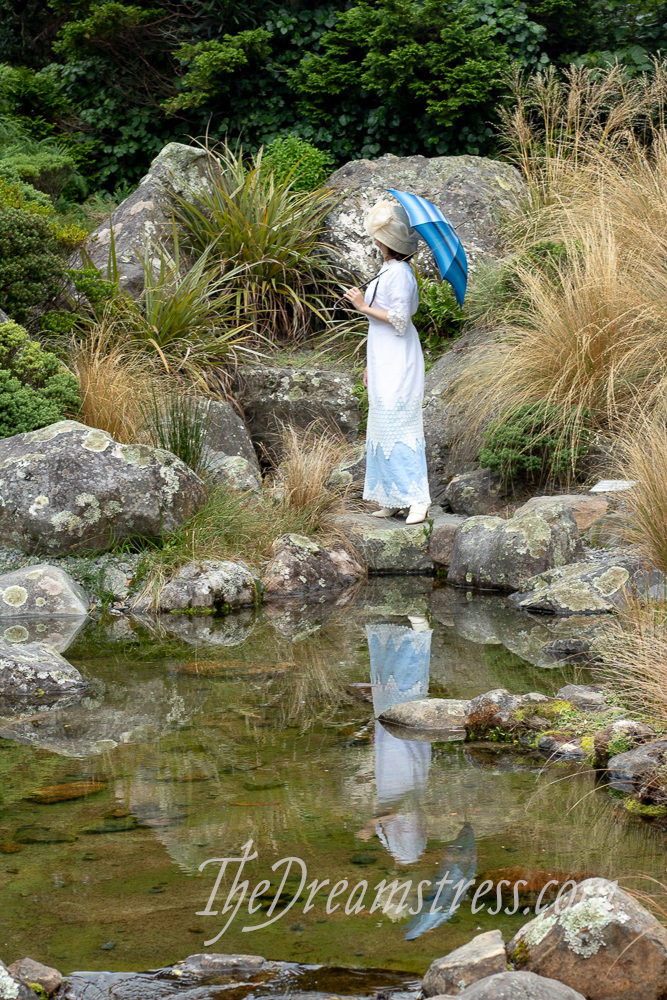
The dress pattern is based on a number of sources: a couple of pattern diagrams published in NZ newspapers in the early 1910s, as well as one in Janet Arnold’s Patterns of Fashion.
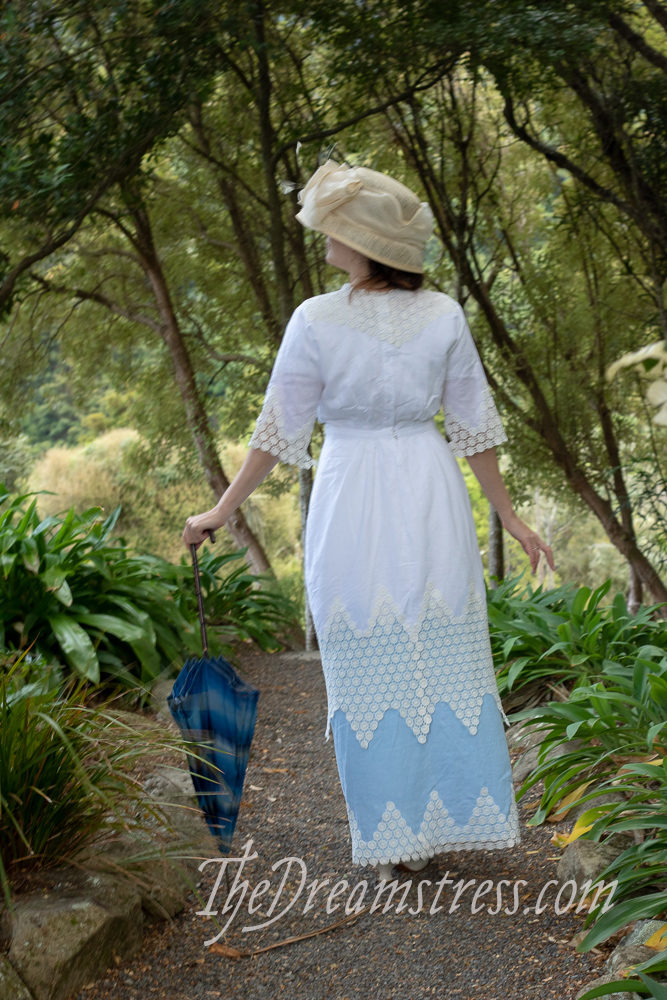
It has a back fastening, the cut-on sleeves that had just become popular in Western fashion, and a two layers skirt. The cut and construction are fairly straightforward**: typical of simpler styles of 1910s lingerie dresses
For the back fastening, I used lingerie buttons that face inwards, so no buttons are seen on the outside. A lighter fastening finish, with little hooks and domes/snaps, would have been a more accurate choice of finish.

The under-layer of the skirt does fasten with domes/snaps:
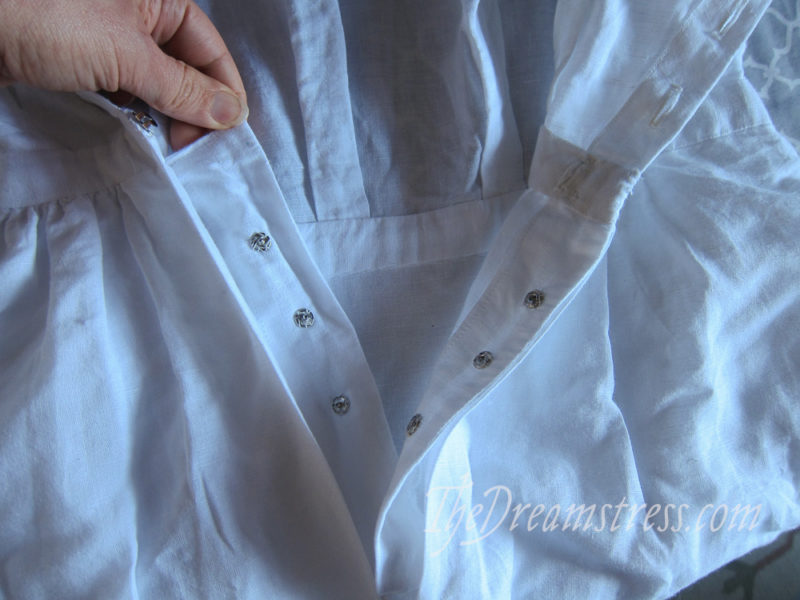
There is no fastening to the over-layer, though it hooks at the top with a skirt hook to close the waist:

The lack of fastenings to the over-layer doesn’t show when the dress is worn:
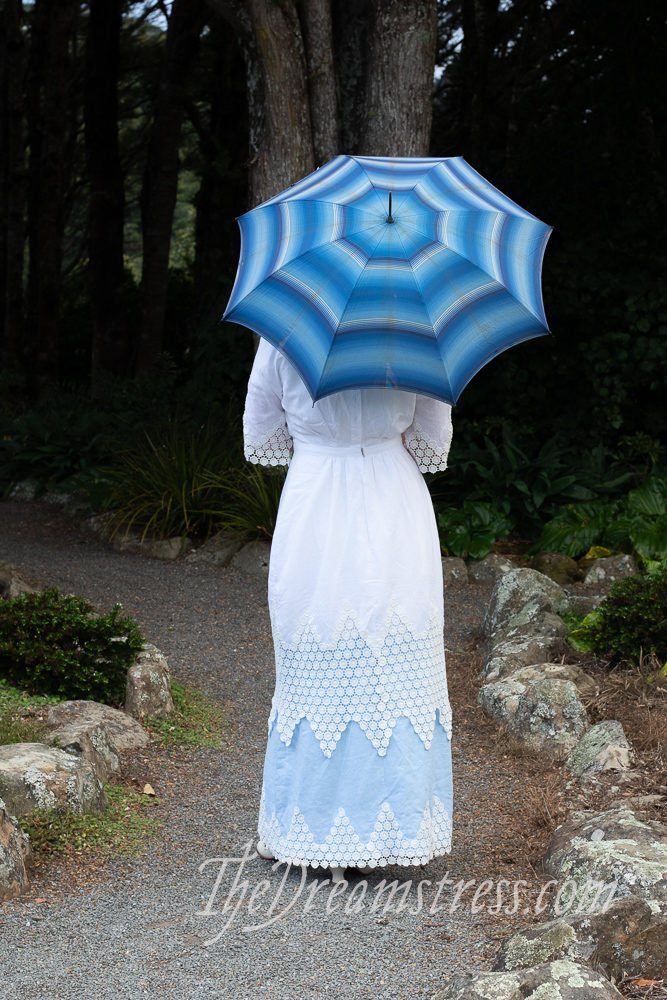
The lace is attached with machine zig-zag stitching:
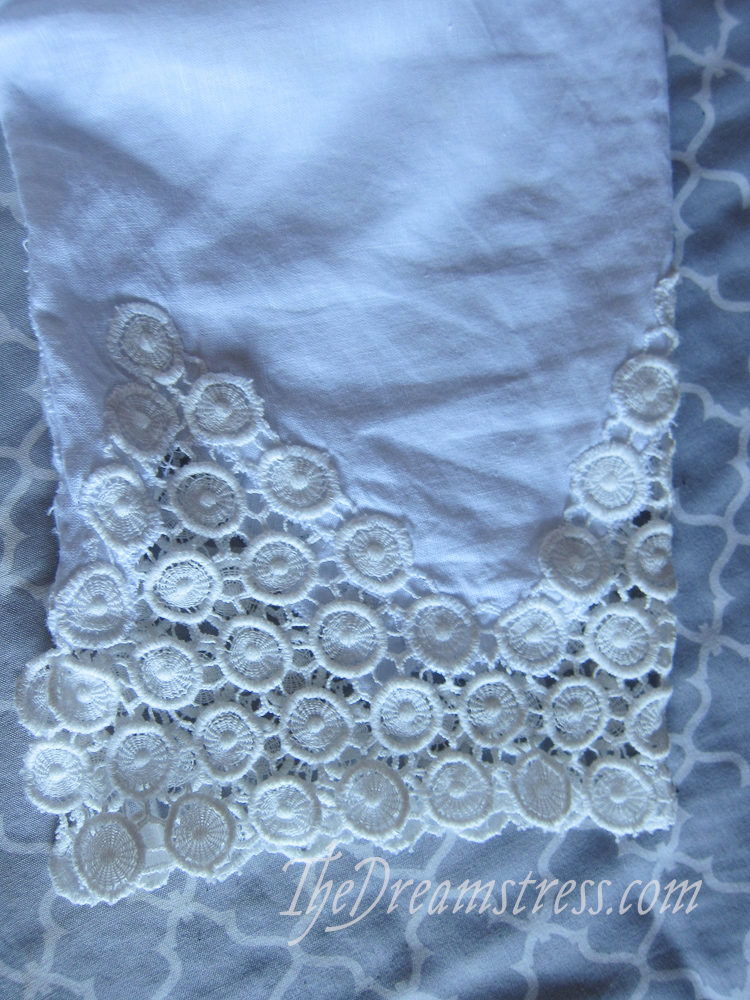
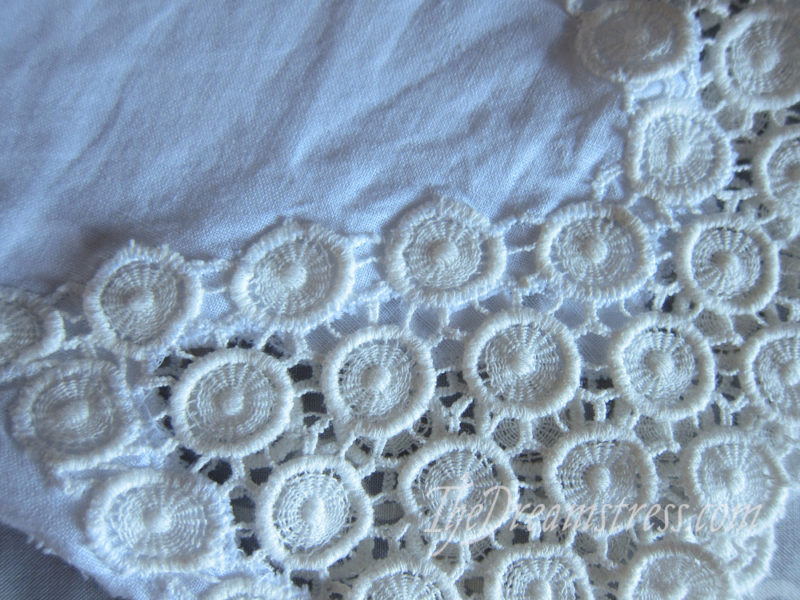
There are lines of zig-zag stitching both along the outer edge of the lace, and then along the inner edge of each motif. After sewing both lines of zig-zagging I trimmed away the fabric to leave the lace free:
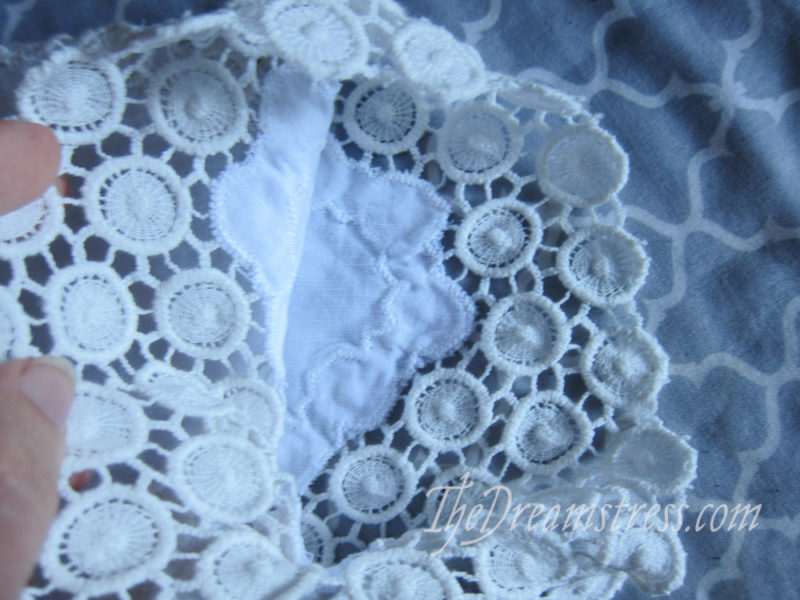
This lets the lace reveal the skin or skirt layers beneath it:
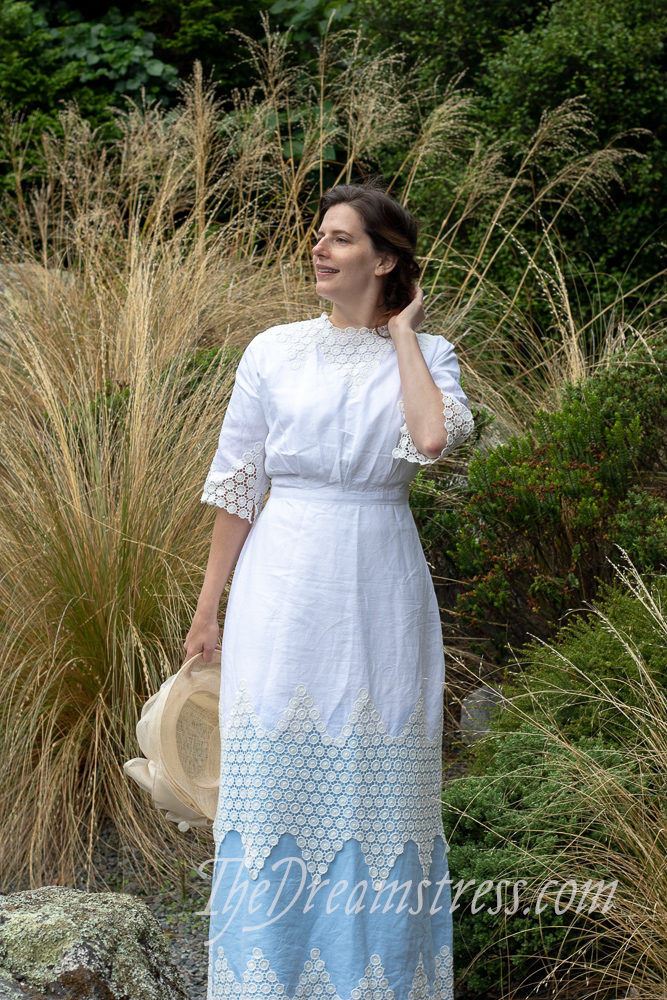
I’ve left the fabric underneath the lace along the bottom lace border, and under the lace yoke of the bodice:
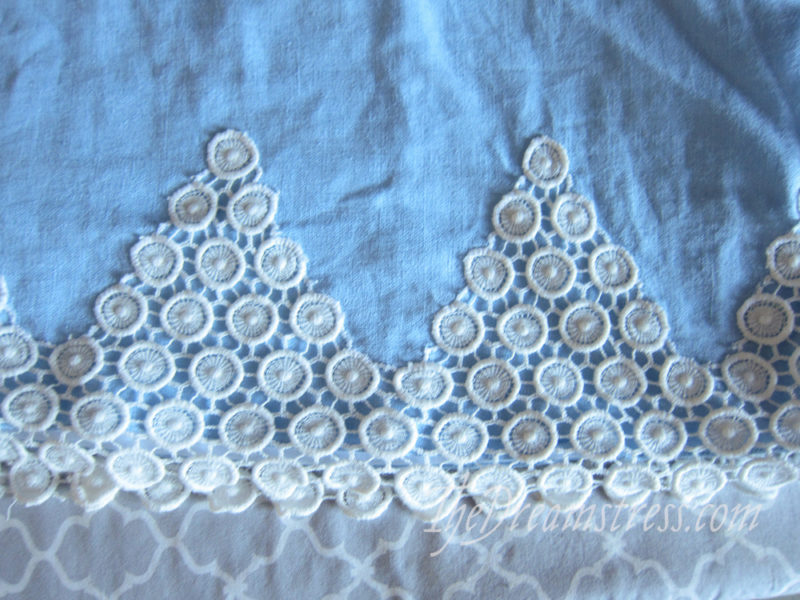
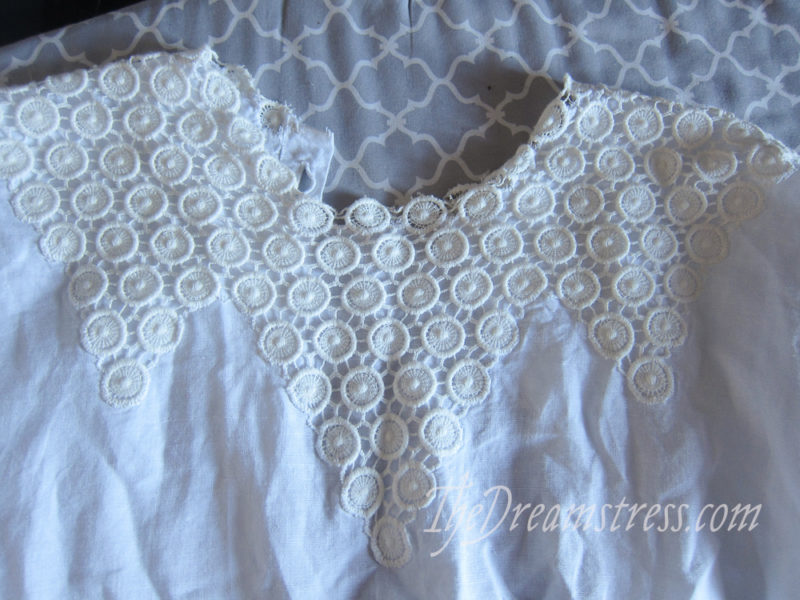
This means that in those places I just had to sew one line of zig-zagging:
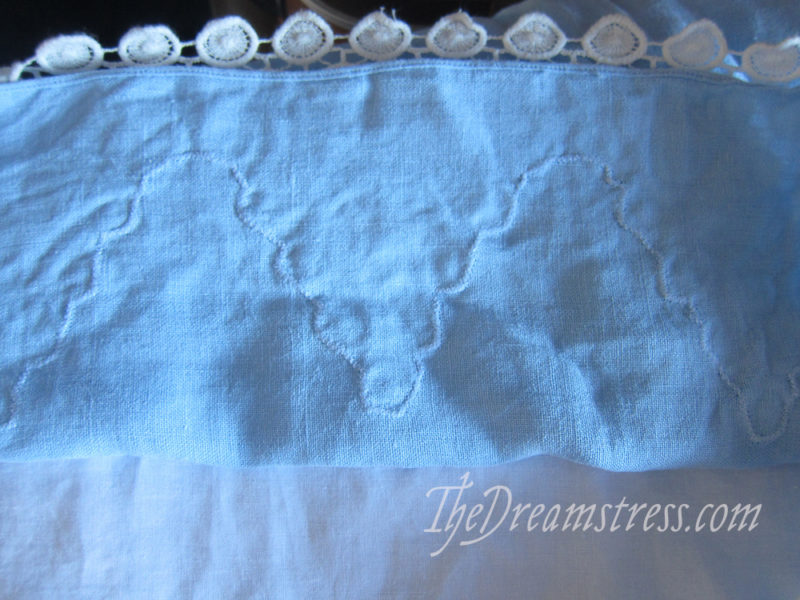
The first few times the dress was worn I left the blue underskirt attached with a straight line of stitching:

I decided I really didn’t love that effect, because it showed through the white linen over-skirt, and looked a little clumsy. So I carefully drew the zig-zags of the overskirt through to the blue underskirt, and sewed then in, and then trimmed away the extra fabric:
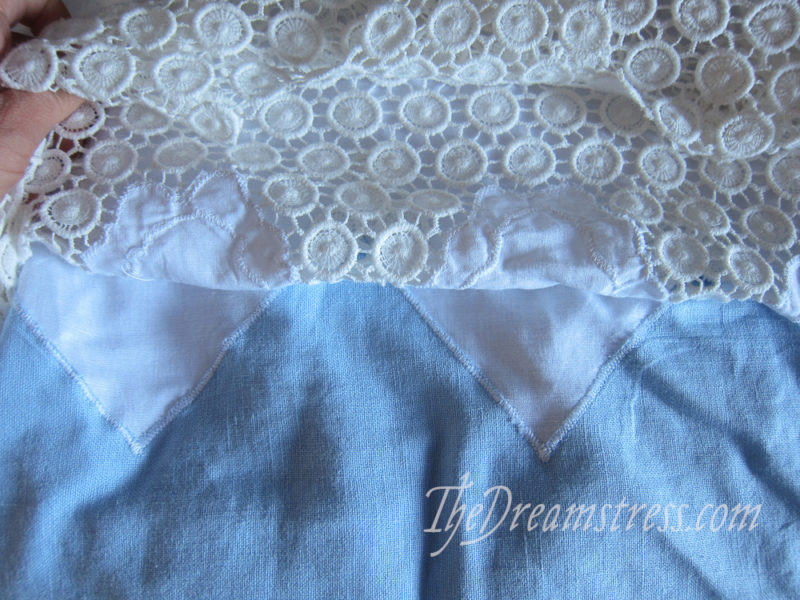
Now the blue just seems to float under the overskirt:
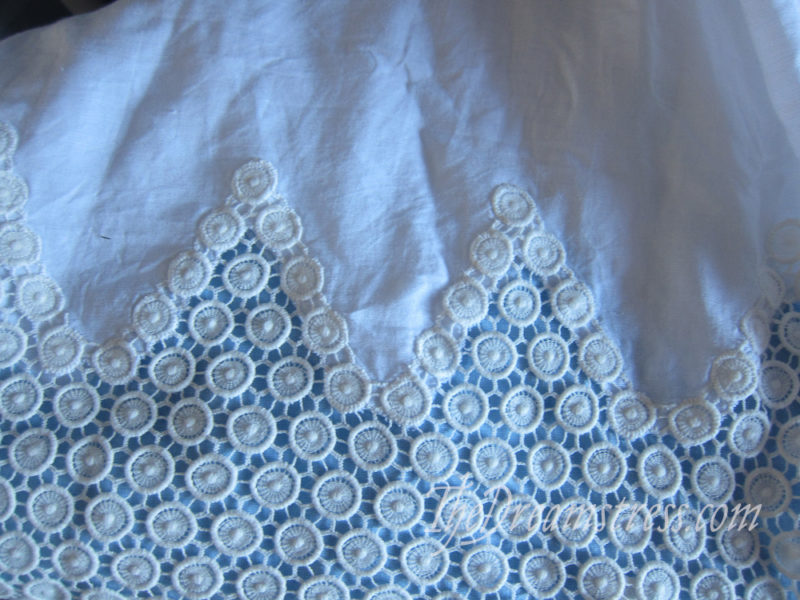
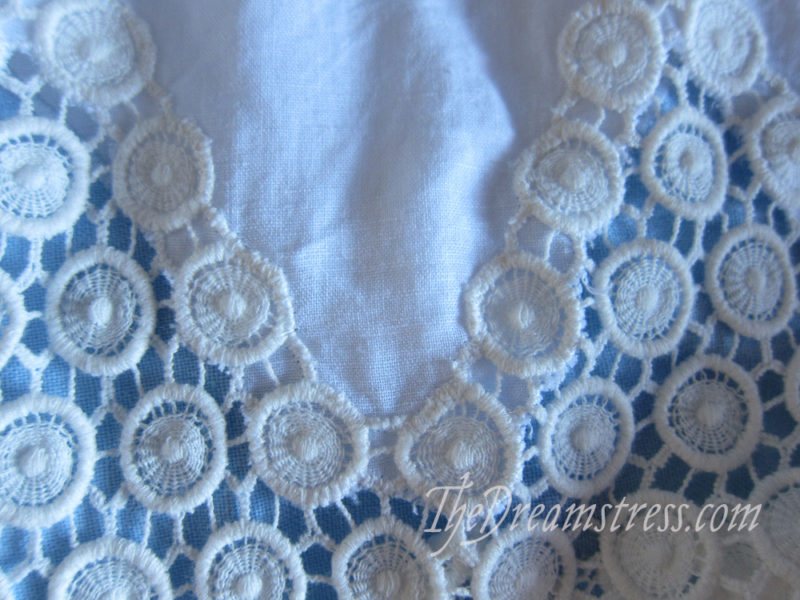
The zig-zags aren’t always perfectly aligned when the dress is worn, because of movement, but they certainly look better than the straight line did!
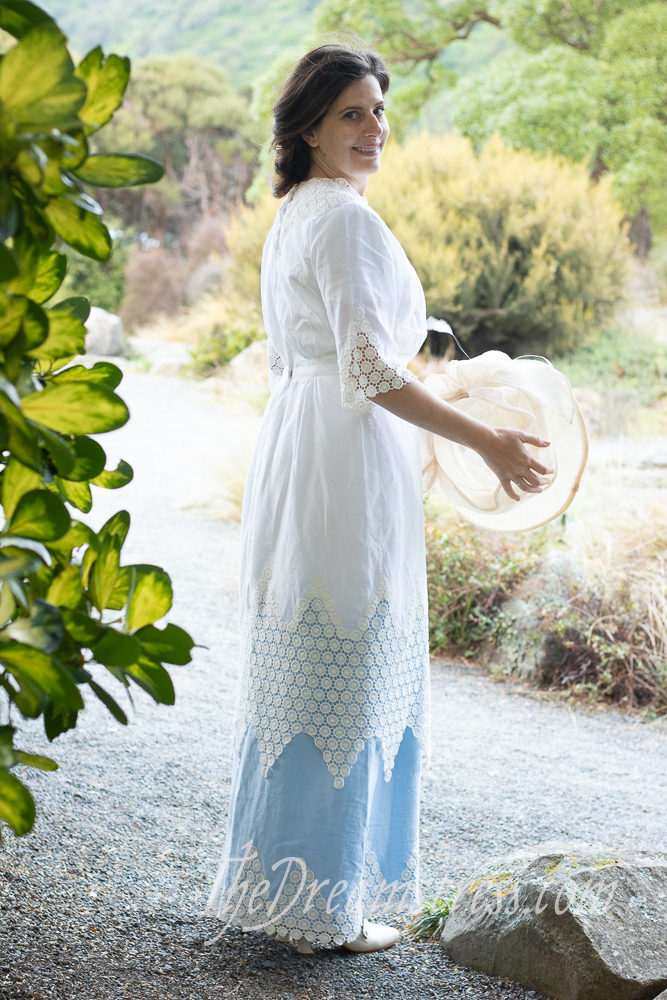
I cheated a bit with hemming, and left the original tablecloth hem of the blue overskirt intact:

And did a bias finished hem with machine invisible hem-stitching (shhhhh!) on the
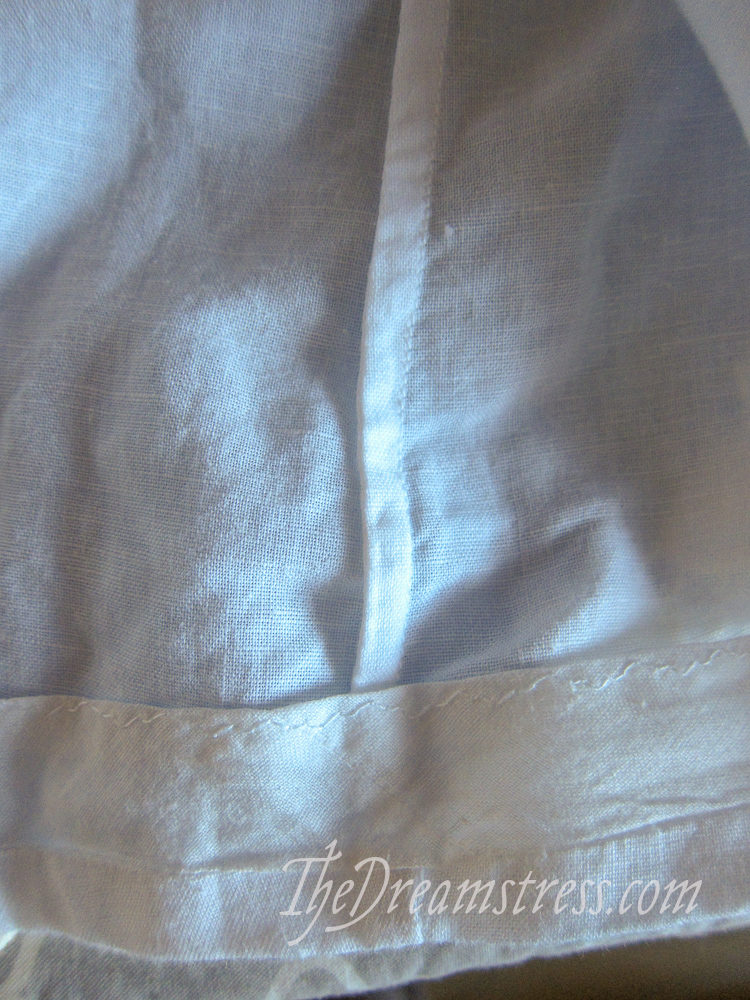
All the seams are french seams, and the waist is finished with an interior waistband, so there is no raw fabric anywhere on the dress:

The dress is much heavier and bulkier in construction than any lingerie dress I’ve worked with, simply because its so hard to find linen that is as light and fine as original Edwardian linen. But I’m still happy with it as a costume, if not a strictly accurate reproduction.
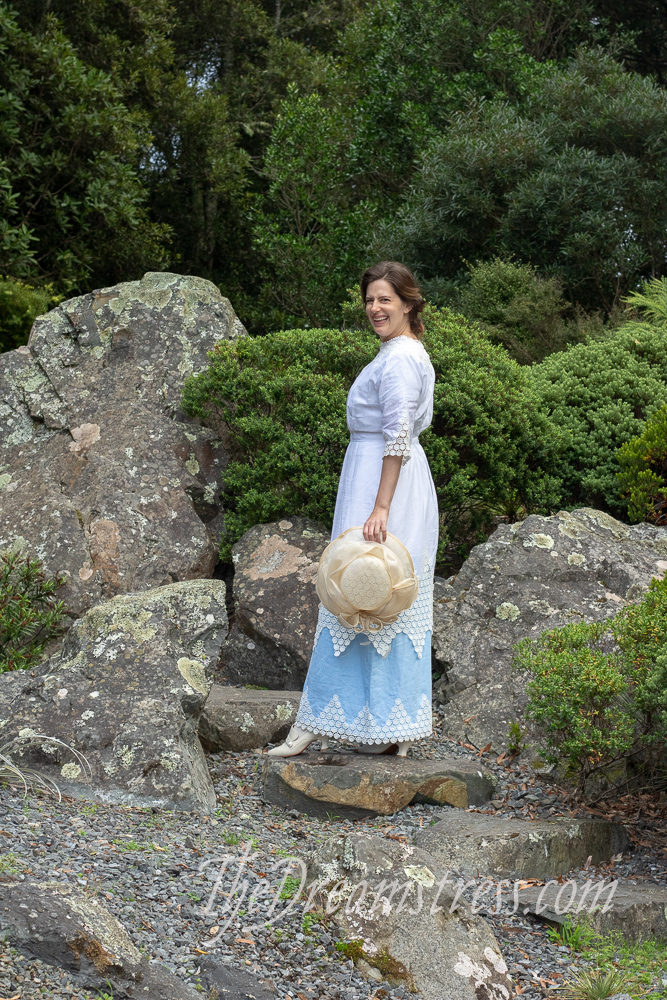
* I love this title because it really annoys an app on WordPress that tells me how ‘readable’ my post is. The app is constantly telling me that my posts don’t contain enough outbound links, or active sentences, or are too hard too read because I use too many words with over six letters, and too many sentences with over 25 words. The app stresses me. (it would like that sentence though. Nice and short). It particularly doesn’t like long titles. My titles are always too long.
The app’s definition of a ‘good’ post does not include a single one of my top 50 most popular posts, so…
I’m trying to ignore it. And when I can’t ignore it, I annoy it. I aim to construct titles which would make the most verbose of Victorian authors gratified, and write substantial paragraphs, abounding with the most excessively long sentences, replete with seven-letter + words (and parentheses, which it is convinced are indisputably heinous), and which, above all else, use oxford commas. (I just know the app hates oxford commas. It’s that kind of app.)
** Well, straightforward for the Edwardian era!


I love this dress and I totally want that app to GET IN THE SEA like you do. We are not all illiterate flizziwigs of doinkiness.
I hadn’t realized that you, or anyone else have been contending with such a regrettable app. I applaud you for striving to overcome and transcend its infantilising suggestions. Thank you for the clarity, wit, tone and content of your writing.
I love that dress. I’d love to have somewhere to *wear” that dress.
Also, I think the WordPress app has misjudged your audience.
Bwa ha ha ha, I know of one WordPress app and one chrome app that I have that get mad at me regularly for my writing. Long live the Oxford Comma!
Haha, I sort of wonder why you bother with the app at all??? I love your long post names, paragraphs, and word choices! And the desire to annoy the app! 😉 (And the dress, too! It is lovely!)
Best,
Quinn
3 cheers for the Oxford Comma!!!
The only way to differentiate:
“We invited the strippers, Reagan, and Pence” (more than two people)
With…
“We invited the strippers, Reagan and Pence” (two very surprisingly dressed politicians)
And much more family-friendly (but trigger warning for cannibalism!)
“Let’s eat Grandma!” “Let’s eat, Grandma!” Commas save lives.
You write YOU, Leimomi, along with all the others who enjoy their sentences Proustian and their commas replete. I love spending time on this blog, and it seems that we have all discovered a shared community.
So, I am not the only one whose writing style is shamed by WordPress. I, too, am always being told that my sentences are too long, insufficiently active, and full of big words. (Thank you Dickens for teaching me the English language).
I have also pretty much decided to ingnore the blessed thing. Short sentences are choppy and I quit using them in 3rd grade.
I am glad I am not the only one who has chosen vocabulary and form, over the readability test.
I absolutely adore your language; your linguistic complexities are well-chosen and never gratuitously applied. I find your elucidation witty, illustrative, and clever; but never in a fashion that obfuscates your meaning, which is fortunate, given how your words must describe a visual art.
Go you.
That second-last sentence is an app annoying masterpiece!
I just had to comment because I read this post from start to finish. Just saying. The title just puzzled me. Why Miss Muffet?
Also. omg that dress is divine. I want to make something like it one day…. *dreams*
Also the app didn’t seem to notice you didn’t finish one of your sentences. So it’s a lousy app anyway 😛
“The app is constantly telling me that my posts don’t contain enough outbound links, or active sentences, or are too hard too read because I use too many words with over six letters, and too many sentences with over 25 words.”
I had a long career as a technical writer and editor. In my professional opinion the app is wrong. Your writing is entertaining, literate, and comprehensible. Please continue to ignore it.
That dress is charming. I like the river of cool blue.
Lovely dress! Absolutely wonderful asterisked footnote!
I commend you for your assiduity in striving to irritate the officious little blighter of an app which seeks to render all writing sterilely similar. I say go tell that app where it can apply itself 😉 and vive la resistance!
I shudder to think what such an app would make of my blog posts. Far too many long words and subsidiary clauses, and myriads of parentheses.
I like the modification you did with the blue skirt detail – it makes the skirt seem more streamlined. What lovely photos, too!
And oh, the sheer stupidity of apps designed to ‘help’! I, Leimomi, and all manner of other people, are perfectly capable of writing varied, amusing, and enlightening articles, comments, blog posts, essays et cetera without the ‘help’ of a niggling little personal assistant trying to make things ‘easier’. Fie! Let us be, with all the spelling mistakes and inconsistencies that may creep in, and enjoy the art of the written word.
(I imagine you have been rather amused, as was I, by reading all these vituperative comments against imbecilic little apps.)